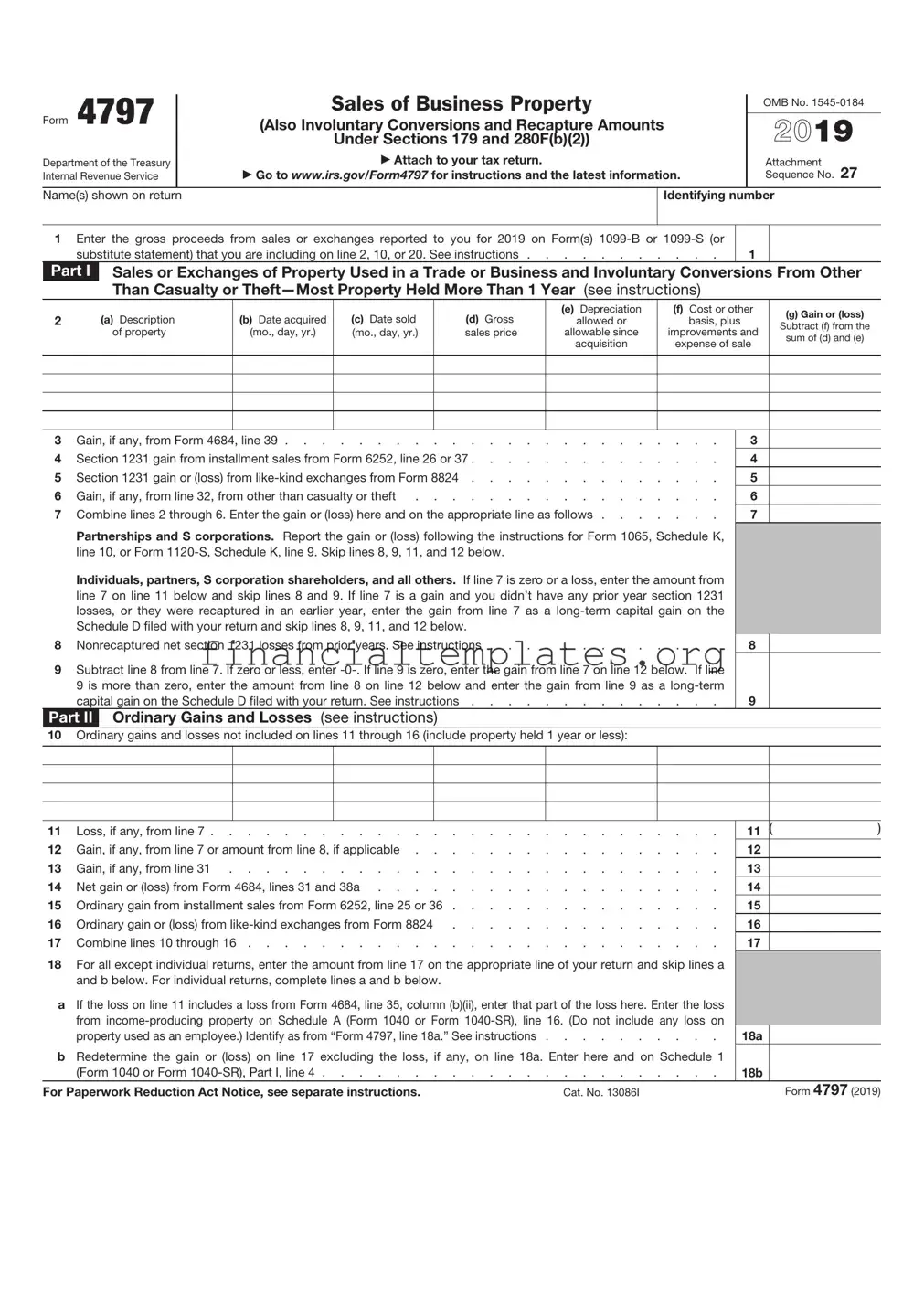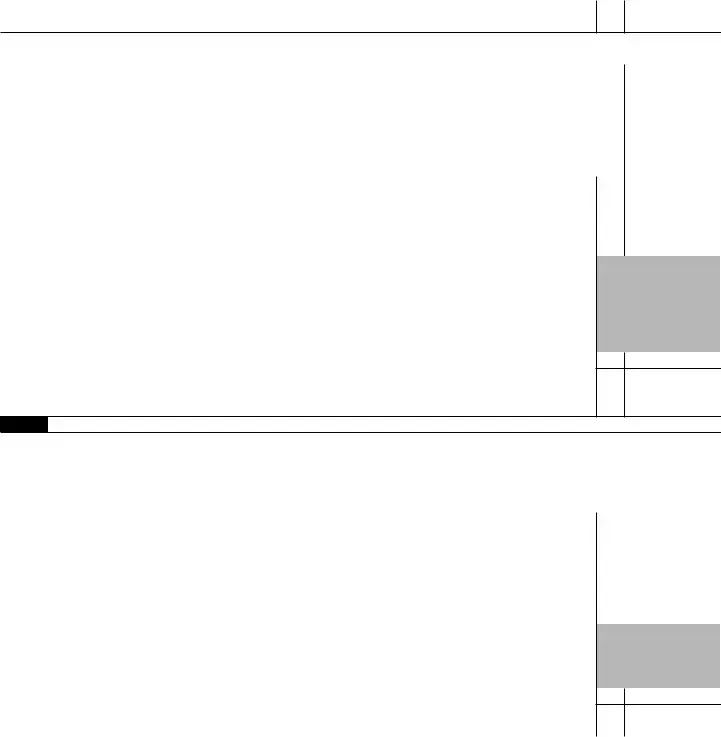Form 4797 |
|
Sales of Business Property |
|
OMB No. 1545-0184 |
|
|
|
|
|
|
|
|
|
|
|
|
|
(Also Involuntary Conversions and Recapture Amounts |
|
2021 |
|
|
Under Sections 179 and 280F(b)(2)) |
|
Department of the Treasury |
|
▶ Attach to your tax return. |
|
Attachment |
27 |
Internal Revenue Service |
|
▶ Go to www.irs.gov/Form4797 for instructions and the latest information. |
|
Sequence No. |
|
|
|
|
|
|
|
Name(s) shown on return |
|
|
Identifying number |
|
|
|
|
|
|
1a Enter the gross proceeds from sales or exchanges reported to you for 2021 on Form(s) 1099-B or 1099-S (or |
|
|
|
substitute statement) that you are including on line 2, 10, or 20. See instructions |
1a |
|
bEnter the total amount of gain that you are including on lines 2, 10, and 24 due to the partial dispositions of
cEnter the total amount of loss that you are including on lines 2 and 10 due to the partial dispositions of MACRS
assets |
. . . . |
1c |
|
Part I |
Sales or Exchanges of Property Used in a Trade or Business and Involuntary Conversions From Other |
|
Than Casualty or Theft—Most Property Held More Than 1 Year (see instructions) |
|
|
2 |
(a) Description |
(b) Date acquired |
(c) Date sold |
(d) Gross |
(e) Depreciation |
(f) Cost or other |
(g) Gain or (loss) |
allowed or |
basis, plus |
|
|
Subtract (f) from the |
|
of property |
(mo., day, yr.) |
(mo., day, yr.) |
sales price |
allowable since |
improvements and |
|
sum of (d) and (e) |
|
|
|
|
|
acquisition |
expense of sale |
|
|
|
|
|
|
|
|
|
|
|
|
|
|
|
|
|
|
|
|
|
|
|
|
|
|
|
|
|
|
|
|
|
|
|
|
|
|
|
|
|
|
|
|
|
|
|
|
|
|
|
3 |
Gain, if any, from Form 4684, line 39 |
3 |
4 |
Section 1231 gain from installment sales from Form 6252, line 26 or 37 |
4 |
5 |
Section 1231 gain or (loss) from like-kind exchanges from Form 8824 |
5 |
6 |
Gain, if any, from line 32, from other than casualty or theft |
6 |
7 |
Combine lines 2 through 6. Enter the gain or (loss) here and on the appropriate line as follows |
7 |
|
Partnerships and S corporations. Report the gain or (loss) following the instructions for Form 1065, Schedule K, |
|
|
line 10, or Form 1120-S, Schedule K, line 9. Skip lines 8, 9, 11, and 12 below. |
|
|
Individuals, partners, S corporation shareholders, and all others. If line 7 is zero or a loss, enter the amount |
|
|
from line 7 on line 11 below and skip lines 8 and 9. If line 7 is a gain and you didn’t have any prior year section |
|
|
1231 losses, or they were recaptured in an earlier year, enter the gain from line 7 as a long-term capital gain on the |
|
|
Schedule D filed with your return and skip lines 8, 9, 11, and 12 below. |
|
8 |
Nonrecaptured net section 1231 losses from prior years. See instructions |
8 |
9Subtract line 8 from line 7. If zero or less, enter -0-. If line 9 is zero, enter the gain from line 7 on line 12 below. If line 9 is more than zero, enter the amount from line 8 on line 12 below and enter the gain from line 9 as a long-term
capital gain on the Schedule D filed with your return. See instructions |
9 |
Part II Ordinary Gains and Losses (see instructions)
10Ordinary gains and losses not included on lines 11 through 16 (include property held 1 year or less):
|
|
|
|
|
|
|
|
|
|
|
|
|
|
|
|
|
|
|
|
|
|
|
|
|
|
|
|
|
|
|
|
|
|
|
|
|
|
|
|
11 |
Loss, if any, from line 7 |
11 |
( |
) |
12 |
Gain, if any, from line 7 or amount from line 8, if applicable |
12 |
|
|
13 |
Gain, if any, from line 31 |
13 |
|
|
14 |
Net gain or (loss) from Form 4684, lines 31 and 38a |
14 |
|
|
15 |
Ordinary gain from installment sales from Form 6252, line 25 or 36 |
15 |
|
|
16 |
Ordinary gain or (loss) from like-kind exchanges from Form 8824 |
16 |
|
|
17 |
Combine lines 10 through 16 |
17 |
|
|
18For all except individual returns, enter the amount from line 17 on the appropriate line of your return and skip lines a and b below. For individual returns, complete lines a and b below.
aIf the loss on line 11 includes a loss from Form 4684, line 35, column (b)(ii), enter that part of the loss here. Enter the loss from income-producing property on Schedule A (Form 1040), line 16. (Do not include any loss on property used as an
employee.) Identify as from “Form 4797, line 18a.” See instructions |
18a |
bRedetermine the gain or (loss) on line 17 excluding the loss, if any, on line 18a. Enter here and on Schedule 1
(Form 1040), Part I, line 4 |
18b |
For Paperwork Reduction Act Notice, see separate instructions. |
Cat. No. 13086I |
Form 4797 (2021) |
Form 4797 (2021) |
|
|
|
Page 2 |
Part III |
Gain From Disposition of Property Under Sections 1245, 1250, 1252, 1254, and 1255 |
|
|
|
(see instructions) |
|
|
|
|
19 |
(a) |
Description of section 1245, 1250, 1252, 1254, or 1255 property: |
|
(b) Date acquired |
(c) Date sold |
|
(mo., day, yr.) |
(mo., day, yr.) |
|
|
|
|
|
|
|
|
|
|
|
|
|
|
A |
|
|
|
|
|
|
|
B |
|
|
|
|
|
|
|
C |
|
|
|
|
|
|
|
D |
|
|
|
|
|
|
|
|
These columns relate to the properties on lines 19A through 19D. |
Property A |
Property B |
Property C |
Property D |
|
▶ |
|
|
|
20 |
Gross sales price (Note: See line 1a before completing.) . |
|
20 |
|
|
|
21 |
Cost or other basis plus expense of sale |
|
21 |
|
|
|
22 |
Depreciation (or depletion) allowed or allowable . . . |
|
22 |
|
|
|
23 |
Adjusted basis. Subtract line 22 from line 21. . . . |
|
23 |
|
|
|
24 |
Total gain. Subtract line 23 from line 20 |
24 |
|
|
|
25 |
If section 1245 property: |
|
|
|
|
a |
Depreciation allowed or allowable from line 22 . . . |
|
25a |
|
|
|
b |
Enter the smaller of line 24 or 25a |
25b |
|
|
|
26If section 1250 property: If straight line depreciation was used, enter -0- on line 26g, except for a corporation subject to section 291.
a Additional depreciation after 1975. See instructions . |
26a |
bApplicable percentage multiplied by the smaller of line
24 or line 26a. See instructions |
26b |
cSubtract line 26a from line 24. If residential rental property
|
or line 24 isn’t more than line 26a, skip lines 26d and 26e |
26c |
d |
Additional depreciation after 1969 and before 1976. . |
26d |
e |
Enter the smaller of line 26c or 26d |
26e |
f |
Section 291 amount (corporations only) |
26f |
g |
Add lines 26b, 26e, and 26f |
26g |
27If section 1252 property: Skip this section if you didn’t dispose of farmland or if this form is being completed for a partnership.
a |
Soil, water, and land clearing expenses |
27a |
b |
Line 27a multiplied by applicable percentage. See instructions |
27b |
c |
Enter the smaller of line 24 or 27b |
27c |
28 |
If section 1254 property: |
|
aIntangible drilling and development costs, expenditures for development of mines and other natural deposits,
|
mining exploration costs, and depletion. See instructions |
28a |
b |
Enter the smaller of line 24 or 28a |
28b |
29 |
If section 1255 property: |
|
a |
Applicable percentage of payments excluded from |
|
|
income under section 126. See instructions . . . . |
29a |
b |
Enter the smaller of line 24 or 29a. See instructions . |
29b |
Summary of Part III Gains. Complete property columns A through D through line 29b before going to line 30.
30 |
Total gains for all properties. Add property columns A through D, line 24 |
30 |
31 |
Add property columns A through D, lines 25b, 26g, 27c, 28b, and 29b. Enter here and on line 13 |
31 |
32Subtract line 31 from line 30. Enter the portion from casualty or theft on Form 4684, line 33. Enter the portion from
|
other than casualty or theft on Form 4797, line 6 |
. . . . . . |
|
32 |
Part IV |
Recapture Amounts Under Sections 179 and 280F(b)(2) When Business Use Drops to |
50% or Less |
|
|
(see instructions) |
|
|
|
|
|
|
|
|
(a) Section |
(b) Section |
|
|
|
179 |
|
280F(b)(2) |
33 |
|
|
|
|
|
Section 179 expense deduction or depreciation allowable in prior years |
|
33 |
|
|
34 |
Recomputed depreciation. See instructions |
|
34 |
|
|
35 |
Recapture amount. Subtract line 34 from line 33. See the instructions for where to report . . |
35 |
|
|
Form 4797 (2021)


